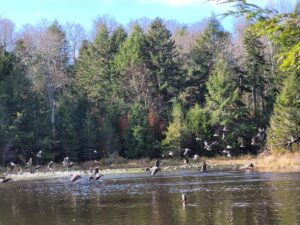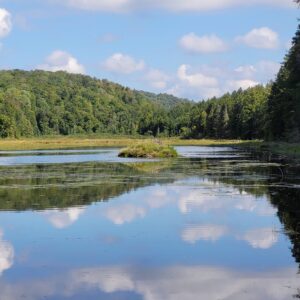Reserve Forestland Category of Current Use
Current use has different categories that land can be enrolled in. Traditionally, the two main categories have been Productive Forestland and Active Agriculture. In 2023 a new classification was added to Current Use called the Reserve Forestland category. This category focuses less on production and more on preserving sensitive areas.
Landowners whose property is in Current Use are encouraged to manage their forests for old-growth in the Reserve Forestland category. Over time, will help establish larger areas of this rare forest type in Vermont.
There are many benefits to having more old-growth on the landscape. One is an increase in old-growth dependent species, which includes lichens, mosses and fungi; avian species such as the Northern Goshawk and Black-backed Woodpecker; and mammals such as martens. Another benefit is the increased amount of carbon stored in old-growth forests.
How Does Reserve Forestland Work?
The way the Reserve Forestland category works is that if your land has enough qualified sensitive areas, then your entire parcel can be put in the Reserve Forestland category. Sensitive areas are defined as steep slopes (greater than 35%), riparian areas, unproductive regions, Ecologically Significant Treatment Areas (ESTAs), special places and other sensitive sites. Long Meadow Resource Management can help you determine which areas of your property are qualified sensitive areas.
The extent of sensitive areas needed to enroll in the Reserve Forestland category varies by parcel size. If you have more than 100 acres enrolled in Current Use, then at least 30% those enrolled acres must be sensitive areas. Properties with less than 100 acres enrolled need at least 50% of the enrolled acres to be qualifying sensitive areas.
co
How Do I Enroll in Reserve Forestland?
Enrolling in the Reserve Forestland category is much the same as enrolling in traditional Current Use categories. It requires a forest inventory, management plan and map submitted to the County Forester. If your property is already in Current Use, then a plan amendment is needed.
One caveat is that more data needs to be gathered to enroll land in the Reserve Forestland category than is needed for the traditional Productive Forestland category. Quantitative data is required for regeneration, deer browse pressure, invasive species colonization, coarse woody material, old-growth characteristics, and impacts of forest roads and trails. This means that additional inventory and mapping work needs to be done to enroll property in the Reserve Forestland category.
Learn More About Reserve Forestland
Please feel free to call us at (802) 658-2368, or use the contact form below, if you would like to learn more about enrolling your property in the Reserve Forestland category of Vermont's Current Use program.


